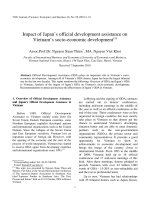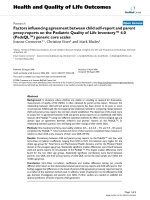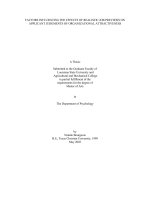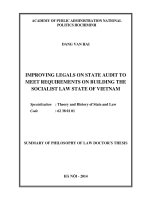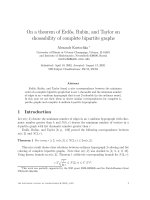Factors influencing customer’s trust when purchasing on facebook social network
Bạn đang xem bản rút gọn của tài liệu. Xem và tải ngay bản đầy đủ của tài liệu tại đây (457.18 KB, 13 trang )
An Giang University Journal of Science – 2019, Vol. 6, 26 – 38
FACTORS INFLUENCING CUSTOMER’S TRUST WHEN PURCHASING
ON FACEBOOK SOCIAL NETWORK
Tran Thi My Phuong1
An Giang University
1
Information:
Received: 10/06/2018
Accepted: 14/09/2018
Published: 02/2019
Keywords:
Trust, trust propensity,
testimonials, risk
ABSTRACT
Trust is the key element for the success of trading on Facebook, therefore,
finding the factors influencing trust of customers is necessary. The research
inherited four factors from the research model of Nor, Nazarie, and Yusoff
(2013): (1) Trust Propensity, (2) Testimonials, (3) Experience in Online
Purchasing, (4) Financial Perceived Risk and based on the interview, the
study developed two more factors: (5) Product Perceived Risk and (6) Time
Perceived Risk. After surveying 200 customers, the research shows that Trust
Propensity affects the most positively to Online Trust and Financial
Perceived Risk affects negatively to Online Trust. The study implicates to
help management build their customers’ trust as well as offers a particular
reality in an e-commerce research field.
1. INTRODUCTION
majority of Internet users are not confident to
make a purchasing decision on Facebook.
According to Gefen (2000), Harn, Khatibi and
Ismail (2006), lack of trust is a major barrier in an
online purchase. This can be explained that
Facebook users are unlimited and there has been
no legal organization regulating trading activity
on it. It is easy for a person to cheat customers out
of money on Facebook.
Purchasing online has been developing
dramatically in all corners of the world due to its
practical benefits such as help customers save
time, compare prices, access new products easily,
and save transportation cost as well as avoid
traffic congestion. Recently, a large number of
customers has moved to shop on social networks,
especially Facebook instead of buying on formal
websites such as Vatgia.com or Lazada.vn.
Facebook is considered as a public house of oneseventh of world’s population and one- third of
Vietnamese
population
(VNNIC,
2013).
Individuals and businesses, therefore, are taking
advantage of this medium to both sell products
and keep in touch with their friends (Ranganathan
& Ganapathy, 2002).
Nevertheless, most of the studies focused on the
traditional e-commerce and there are few types of
researches conducted to examine factors that
affect customer’s trust on Facebook. This study
aims to fill in this gap in order to help businesses
increase their customer’s trust by some particular
actions; besides, its results can reliably contribute
to research of e-commerce field in general.
In spite of many advantages mentioned above, the
2. LITERATURE REVIEW
26
An Giang University Journal of Science – 2019, Vol. 6, 26 – 38
2.1 Trust and Online Trust
orders or write testimonials about some certain
products. However, everything has its two sides,
Facebook has some disadvantages for both sellers
and buyers.
Trust has been identified differently among
researchers. Koufaris and Hampton-Sosa (2004)
suggest that trust is the willingness to rely on a
third party after the first interaction with it.
Another study conducted by Coulter and Coulter
(2002) defined trust as a key factor to build longterm relationships between service representatives
and their customers.
2.3 Some typical researches
Customer’s Trust
on
Online
Many studies have been conducted to investigate
factors that influence customers’ trust in an online
purchase. One of recent research is by Nor,
Nazarie, and Yusoff (2013). They studied the
factors influencing individuals’ trust in an online
purchase through social network sites and the
results discovered that (1) Trust propensity, (2)
online purchasing experiences, (3) testimonials,
and (4) money risk affect customers’ trust in
online purchase. The authors surveyed 129
customers who come from Malaysia, China, by
sending emails and uploading the questionnaires
on their individual Facebook accounts. Especially,
the research used the method of multiple
regression analysis to test the relation of the
factors and discovered that testimonials have the
strongest effect on customer’s trust. In other
words, good comments and feedbacks which
come from old customers are advantageous for
attracting new customers and building stable
relations among existing customers.
In the Internet shopping platform, online trust is
also the willingness of a consumer to be
defenseless to the actions of an Internet business
and based on the hopes that he or she will be
treated agreeably, regardless of the ability of the
consumer to regulate or control the Internet
business (Lee & Turban, 2001). Meanwhile, Hui
and Kejin (2009) defined online trust as a process
including requirement, attitude, intention, and
purchase behavior.
From various definitions, trust shows an
important role in online shopping. Without trust,
customers are not confident enough to make
online purchasing decision and businesses can not
establish sustainable relationships with their
customers.
2.2 Social Networks (SNs)
SNs is the top of Internet applications which
allows users to create profiles and keep contact
with friends who are already registered on the site.
Some of the examples are MySpace, Facebook,
Friendster and Twitter. In Vietnam, Facebook has
about 9 million users (Comscore, 2012) and
becomes a phenomenon in the youngsters even
the elderly and the kids. One of the special
functions of Facebook is that users can upload
their photos and make their information visible to
their friends. This enables them to communicate
more effectively and make friends unlimitedly. In
terms of e-commerce, sellers find it easy to
describe the products and services, and convenient
to reply customer’s questions on Facebook, while
buyers think it easy to approach new products
from their favorite Facebook stores, easy to place
Moreover, Gefen (2000) also studied the role of
familiarity and trust in an e-commerce context. He
analyzed the relations of five factors: (1)
familiarity, (2) trust propensity, (3) trust, (4)
inquiring, and (5) purchasing. The results show
that both familiarity with an Internet vendor and
its processes as well as trust in the vendor
influenced purchasing intension Therefore, it is
necessary to concentrate on building trust by
increasing familiarity. Moreover, the study proved
that familiarity is primarily people's disposition to
trust that influenced their trust in the venders.
In addition, another important research was
conducted by Kim et al. (2007) on “A trust-based
consumer decision-making model in electronic
commerce: The role of trust, perceived risk, and
27
An Giang University Journal of Science – 2019, Vol. 6, 26 – 38
their antecedents”. This study focused on
developing a theoretical framework which
describes the trust-based decision-making process
that a consumer uses when purchasing on the
Internet and on examining the model which use
Structural Equation Modeling method. The study
results show that online trust and perceived risk
affect customer’s purchasing decisions strongly.
factors mentioned and repeated in most of the
researches are Trust Propensity, Online
Purchasing Experience, Testimonials, and
Perceived Risks. This inspires the author to
implement a study to survey the factors
influencing customer’s online trust when
purchasing on Facebook.
In Vietnam, the number of research on online trust
has been increasing. Tran Minh (2012) studied
“Factors affecting customer trust in online
shopping in Vietnam”. The author proposed a
research model including four factors affecting
trust in online shopping: (1) Privacy Perceptions,
(2) Security Protection, (3) Perceived Risks, and
(4) Perceived Benefits. The study used
convenience sampling and purposing sampling to
select 216 Vietnamese students and office
workers who used to shop online by electronic
payments. The results proved that Perceived Risks
and Privacy Perceptions have strong impacts on
online trust. This is explained that in a developing
country like Vietnam, customers are not familiar
with online shopping. Therefore, they tend to care
about risks rather than profits.
3.1 Research methodology
3. Research methodology and hypothesis
The study was implemented by combining
quantitive and qualitative research methodology.
After reviewing a wide range of national and
international papers and researches related to
online trust, the author conducted six focus
interviews with six customers who had purchased
on Facebook in order to compare the previous
results to the reality and to find out new factors.
An online questionnaire was prepared and
developed based on the previous results and focus
interviewed results. The study used convenience
sampling method which allows reaching the
responders who are available conveniently to
participate in the study and targeted Facebook
users who had purchased on Facebook. All of 38
dependent and independent variables were
measured by Likert 5 scales.
Furthermore, Nguyen Mai Trang and Nguyen
Ngoc Bich Tram (2014) studied about the factors
affecting actual use of Facebook in Vietnam by
examining six factors: (1) Social Identity, (2)
Altruism, (3) Telepresence, (4) Perceived ease of
use, (5) Perceived usefulness, and (6) Perceived
encouragement. There were 363 Facebook users
in Ha Noi, Da Nang, and Ho Chi Minh City
taking part in the survey. The results indicated
that Perceived ease of use, Perceived usefulness,
and Perceived encouragement influence directly
on the actual use of Facebook.
3.2 Research hypothesis
Trust propensity was mentioned in several types
of researches on e-commerce. According to
McKnight and Chervany (2002), trust propensity
or disposition to trust can be defined as “general
willingness based on extended socialization to
depend on others” and concluded that those who
have a strong belief in human’s good
characteristic may have a high level of trust
propensity. This finding leads to the first
hypothesis of the study:
In conclusion, the above research overview
indicates that in Vietnam most of the studies
concentrated on online purchasing intention or
Facebook-using behavior while many researchers
in the world have investigated online trust
popularly and profoundly in different sides. The
Hypothesis 1: Trust propensity influences
positively on customers’ trust when purchasing on
Facebook.
Testimonials play an important role in online
shopping. Testimonials are sentences spoken or
28
An Giang University Journal of Science – 2019, Vol. 6, 26 – 38
written about some feelings of customers after
they experienced the products or services with a
hope that they can recommend or prevent other
customers from buying a particular product or
service. In social networks, customers can write
their testimonials publicly or send a message
privately (Dwyer, Hiltz & Passerini, 2007). That
is the reason why businesses on Facebook try to
gather more and more positive testimonials about
their product or service to enhance their
customers’ trust. Therefore, the second hypothesis
is suggested.
such as phone numbers, home address, e-mail
address, and debit or credit card numbers which
are attractive to financial frauds (March, 2006).
Therefore, the fourth hypothesis is proposed.
Hypothesis 4: Financial risk influences negatively
on customers’ trust when purchasing on
Facebook.
Product risk is another widespread issue that
every customer concerns before making a
purchasing decision. Product risk involves both
quality and quantity. In terms of quantity,
customers receive more or fewer items than they
order. In terms of quality, customers receive
products that are not matched to the ones they
order, namely they may be damaged or defective
and they may have different color or size. In
another word, product risk is the loss that
customers get when the provided products are not
matched to the ones that they expect (Horton,
1976). Therefore, the fifth hypothesis is proposed.
Hypothesis 2: Testimonials influence positively
on customers’ trust when purchasing on
Facebook.
Jiang, Chen and Wang (2008) researched on the
relation between knowledge, trust in online
purchasing and online buying intention of
customers. The results pointed out that knowledge
are related positively to trust in online purchasing.
In the words, those who have awareness of online
shopping tend to trust and be willing to shop
online because they can identify risk in online
transactions. The third hypothesis is given.
Hypothesis 5: Product risk influences negatively
on customers’ trust when purchasing on
Facebook.
Despite the convenience of online shopping, a
loss of time may occur in all stages such as
making inquiries, ordering products, paying the
bills, receiving products, even asking for refund.
Roselius (1971) confirmed in his research that
time loss was considered as an additional risk of
products and services. Therefore, the sixth
hypothesis is proposed.
Hypothesis 3: Experience in online purchasing
influences positively on customers’ trust when
purchasing on Facebook.
Purchasing online involves a wide range of
risks in which financial risk is the most
concerned. Most of the cases, the customers lose
their money by sending money in advance and do
not receive their ordered products or receive
dissatisfied ones. Moreover, the customers have to
disclose their personal information to the sellers
Hypothesis 6: Time risk influences negatively on
customers’ trust when purchasing on Facebook.
29
An Giang University Journal of Science – 2019, Vol. 6, 26 – 38
Figure 1. Research Model
4. Research results
4.1 Scale descriptions
is a measure of internal consistency on the closely
level that the variables of the scale correlate with
each other in order to eliminate the inappropriate
variables. According to Nguyen Dinh Tho (2013),
a good reliability scale must have Cronbach’s
Alpha coefficient from 0,70 to 0,80. However, the
Cronbach’s Alpha coefficient of scale from 0,6
upward are accepted. Furthermore, the condition
to carry out Exploratory Factors Analysis (EFA)
is that the variables must have corrected item-total
correlation greater than 0,3 (Nunnally and
Burnstein, 1994).
The data was collected from 200 respondents who
have been purchasing on Facebook and 38% are
male. Most of them are from 22 to 35 years old.
The majority have been buying online for a year
(accounting for 39%), for more than one year
(accounting for 26,5%), and for a month
(accounting for 20,5%).
4.2 Cronbach’s Alpha analysis
The Cronbach’s Alpha coefficient is used to
evaluate the reliability of the scale. In addition, it
Table 1. Results of Cronbach’s Alpha Analysis
Variables
Trust Propensity
Items
Corrected Item-Total
Correlation
Cronbach's Alpha if
Item Deleted
prop1
0,595
0,832
prop2
0,693
0,806
prop3
0,745
0,791
prop4
0,644
0,818
prop5
0,603
0,830
=> Cronbach’s Alpha of the scale
Testimonials
0,847
test1
0,643
0,788
test2
0,532
0,819
test3
0,571
0,810
test4
0,734
0,762
test5
0,656
0,783
30
An Giang University Journal of Science – 2019, Vol. 6, 26 – 38
Variables
Items
Corrected Item-Total
Correlation
=> Cronbach’s Alpha of the scale
Online Purchasing Experience
0,827
ex1
0,632
0,885
ex2
0,687
0,873
ex3
0,753
0,857
ex4
0,769
0,854
ex5
0,803
0,846
=> Cronbach’s Alpha of the scale
Financial Risks
0,888
Fin1
0,702
0,889
Fin2
0,699
0,890
Fin3
0,753
0,878
Fin4
0,811
0,865
Fin5
0,797
0,868
=> Cronbach’s Alpha of the scale
Product Risks
Cronbach's Alpha if
Item Deleted
0,900
Pro1
0,807
0,802
Pro2
0,263
0,922
Pro3
0,832
0,795
Pro4
0,769
0,813
Pro5
0,780
0,812
=> Cronbach’s Alpha of the scale
0,864
Pro1
0,844
0,891
Product Risks
Pro3
0,861
0,885
(After deleting Pro2)
Pro4
0,771
0,915
Pro5
0,808
0,903
=> Cronbach’s Alpha of the scale
Time Risks
0,922
Time1
0,739
0,890
Time2
0,745
0,890
Time3
0,784
0,886
Time4
0,787
0,887
Time5
0,734
0,891
Time6
0,753
0,889
Time7
0,781
0,886
Time8
0,286
0,926
31
An Giang University Journal of Science – 2019, Vol. 6, 26 – 38
Variables
Corrected Item-Total
Correlation
Items
=> Cronbach’s Alpha of the scale
Time Risks
(After deleting Time8)
0,906
Time1
0,740
0,917
Time2
0,767
0,914
Time3
0,793
0,912
Time4
0,793
0,913
Time5
0,730
0,918
Time6
0,774
0,914
Time7
0,774
0,914
=> Cronbach’s Alpha of the scale
Trust
0,926
trust1
0,623
0,901
trust2
0,831
0,857
trust3
0,871
0,847
trust4
0,660
0,894
trust5
0,761
0,873
=> Cronbach’s Alpha of the scale
0,898
In the process of verifying reliability, Pro2 and
Time8 were deleted because they both have
Corrected Item-Total Correlation less than 0.3.
The remaining 36 variables have Cronbach’s
Alpha coefficient of the constituent larger than
0.7; this means that the variables have closely
connected each other in the same factor. The
observing variables in the same factors have itemtotal correlation greater than 0.3; therefore all of
them were put into Exploratory Factors Analysis
(EFA).
4.3 Exploratory
Factor
Independent Variables.
Cronbach's Alpha if
Item Deleted
Analysis
Risks, Online Purchasing Experience, Trust
Propensity, Testimonials. Among them, Test2,
which belongs to Testimonials, had loading
coefficient of less than 0.5 so it was removed
from the scale. Then, another EFA was conducted
in which
KMO test coefficient had a value
of 0.840 > 0.5 showing the suitability of the
analysis to the data (Nguyen Dinh Tho, 2013).
Bartlett's Test of Sphericity is 4006.98 with Sig. =
0.00 < 5%. This asserts that variables closely
connected each other (Nguyen Dinh Tho, 2013).
Cumulative Variance is 71.293 > 50%. In other
words, the first factor can explain 71.29% of the
variation of data (Gerbing and Anderson, 1988).
Moreover, Eigenvalue coefficient is greater than
one.
on
The analysis result shows that the independent
variables gather in groups and have loading
coefficients larger than 0.5. There are six factors
grouped: Time Risks, Financial Risks, Product
32
An Giang University Journal of Science – 2019, Vol. 6, 26 – 38
Table 2. Rotated Component Matrixa after deleting Test2
Component
1
time4
.849
time3
.847
time6
.827
time2
.824
time7
.823
time1
.817
time5
.786
2
fin4
.864
fin3
.857
fin5
.850
fin1
.791
fin2
.791
3
4
ex5
.845
ex4
.819
ex3
.803
ex2
.781
ex1
.739
pro1
.906
pro3
.901
pro5
.892
pro4
.841
5
prop3
.829
prop4
.780
prop2
.724
prop1
.656
33
6
An Giang University Journal of Science – 2019, Vol. 6, 26 – 38
prop5
.642
test4
.832
test5
.757
test1
.729
test3
.595
Extraction Method: Principal Component Analysis.
Rotation Method: Varimax with Kaiser Normalization.
a. Rotation converged in 6 iterations.
4.4 Exploratory
Factor
Dependent Variables.
Analysis
on
In conclusion, after conducting Exploratory
Factor Analysis, six independent variables and
one dependent variable remain as before.
KMO Measure of Sampling Adequacy is 0.833 >
0.5. This means that the test is essential. Bartlett's
Test of Sphericity is 653.509 with Sig. = 0.00<
5% (0.05) showing that the variables correlate
closely each other. Cumulative of Variance is
71,148 >50%.
4.5 Examining the reliability of the scale after
removing Test2
This step aims at re-examining to ensure the scale
is still reliable after removing Test2. Fortunately,
the result makes certain that Cronbach’s Alpha of
the scale get value 0.819 and reliabilities of all
items are larger than 0.5.
The matrix does not rotate because only one
dependent factor was extracted.
Table 3. Cronbach’s Alpha after Removing Test2
Variable
Testimonials
Items
Corrected Item-Total
Correlation
Cronbach's Alpha if Item
Deleted
test1
0,643
0,771
test3
0,546
0,823
test4
0,764
0,715
test5
0,631
0,776
=> Cronbach’s Alpha of the scale
4.6 The result of Pearson
Coefficient Analysis
0,819
Correlation
All of the Sig. values are smaller than 5%. This
means that the Pearson Correlation Coefficient
Analysis results are significant in statistics. The
table shows value from -0.310 to +1, that means
the variables are relevant to each other and can be
used in regression analysis.
After encoding the average value of dependent
and independent variables, the author analyzes the
Pearson correlation in order to find out the
variables that are relevant to each other and to
remove irrelevant or fewer relevant ones.
34
An Giang University Journal of Science – 2019, Vol. 6, 26 – 38
Table 4. Correlation
TRUST
Pearson Correlation
TRUST
TIME
FIN
PROP
PRO
EX
TEST
1
-.250**
-.310**
.551**
-.254**
.512**
.475**
.000
.000
.000
.000
.000
.000
1
.100
-.249**
.184**
.088
.003
.160
.000
.009
.217
.966
1
-.240**
.227**
-.159*
-.096
.001
.001
.025
.177
1
-.086
.362**
.558**
.226
.000
.000
1
.083
.116
.244
.101
1
.489**
Sig. (2-tailed)
TIME
FIN
PROP
PRO
EX
TEST
Pearson Correlation
-.250**
Sig. (2-tailed)
.000
Pearson Correlation
-.310**
.100
Sig. (2-tailed)
.000
.160
Pearson Correlation
.551**
-.249**
-.240**
Sig. (2-tailed)
.000
.000
.001
Pearson Correlation
-.254**
.184**
.227**
-.086
Sig. (2-tailed)
.000
.009
.001
.226
Pearson Correlation
.512**
.088
-.159*
.362**
.083
Sig. (2-tailed)
.000
.217
.025
.000
.244
Pearson Correlation
.475**
.003
-.096
.558**
.116
.489**
Sig. (2-tailed)
.000
.966
.177
.000
.101
.000
.000
1
**. Correlation is significant at the 0.01 level (2-tailed)
*. Correlation is significant at the 0.05 level (2-tailed
N = 200
4.7 Regression analysis
51.8% of the variation of the dependent variable.
Sig. value of F test < 0.05 shows that the model is
statistically significant at significance level 5%. In
addition, VIF coefficients of all factors are < 2
implying that multi-collinearity does not influence
much on regression results.
Regression analysis was conducted between
TRUST and six independent variables (1) Trust
Propensity (PROP), (2) Testimonials (TEST), (3)
Online Purchasing Experience (EX), (4) Time
Risks (TIME), (5) Financial Risks (FIN), (6)
Product Risks (PRO).
All regression coefficients (β) are statistically
significant since Sig. β < 5%. There are three
regression coefficients taking negative sign
corresponding to risk factors that affect negatively
TRUST. All the six hypotheses were therefore
accepted.
The research’s linear regression equation is as
following:
TRUST =β0 + β1 * PROP + β2 * TEST + β3 * EX β4 ATIME- β5 FIN- β6 PRO
With R2 of 0.518 indicating that the independent
variables in the regression model can explain
35
An Giang University Journal of Science – 2019, Vol. 6, 26 – 38
Table 5. Estimates of Coefficientsa
Unstandardized
Coefficients
B
Standardized
Coefficients
Std. Error
(Constant)
2.039
.280
TIME
-.122
.037
FIN
-.082
PROP
Beta
Collinearity
Statistics
t
Sig.
Tolerance
VIF
7.281
.000
-.172
-3.263
.001
.874
1.144
.038
-.113
-2.156
.032
.886
1.128
.229
.065
.227
3.512
.001
.582
1.718
PRO
-.161
.037
-.229
-4.393
.000
.892
1.121
EX
.280
.046
.352
6.069
.000
.722
1.385
TEST
.175
.059
.193
2.958
.003
.571
1.751
a. Dependent Variable: TRUST
5. RESEARCH IMPLICATIONS
can attract. For this reason, it is essential for those
who do business on Facebook to invest in
collecting valuable testimonials from their clients.
In addition to improving product’s quality, online
sellers need to spend time taking care of their
customers such as asking about how they feel
about the products if they have any suggestions
for increasing the product’s quality, or how to
serve them better. By talking to customers,
businesses can both keep track of their demand
and pick out valuable feedbacks to build online
customer’s testimonials corner which is the best
proof for a quality product.
Trust propensity influences positively and most
strongly on customer’s trust. People who have
high trust propensity feel easy to trust in
something they intend to buy. Therefore, online
shops are encouraged to observe meticulously in
order to know their groups of customers who have
a high trust propensity to their products or
services.
In addition, online purchasing experience affects
customers’ trust supportively when they shop on
Facebook. This result reminds online businesses
enabling customers to approach online shopping
process. For instance, shop owners can simplify
the purchasing steps, create more payment
channels, and arrange the easy-to-shop
appearance. Once customers do online
transactions several times, they will get some
certain experience and may become loyal
customers of the stores on Facebook.
The research result also proves that financial risks
influence negatively and the most sharply on
customer’s trust. Problems such as losing money,
losing bank account information, or being charged
exorbitantly mostly always disturb customers. To
avoid them, firstly, business managers need to
disclose different types of payment such as by
cash on delivery (COD), bank account, delivery
companies, electronic money, or charging mobile
phone cards. Each group of customers will be
suitable for each type of payment. Secondly,
opening various bank accounts enables customers
Testimonials include purchasers’ feedbacks,
comments, or suggestions about products or
services that they used. The better testimonials
online businesses have, the more customers they
36
An Giang University Journal of Science – 2019, Vol. 6, 26 – 38
to choose the one they have, therefore, they do not
have to pay any fees for a different bank.
Furthermore, all of the charges related to products
should be listed down clearly to avoid
misunderstanding when paying. In the same way,
the products should be checked considerately so
that the customers do not have to pay another fee
to return or exchange products. Last but not least,
any information of customers must be secured
absolutely.
researches will overcome these limitations and
could focus on the differences between
customer’s trust in purchasing on Facebook and
other e-commerce websites.
REFERENCES
Comscore. (2012). Introduction of Online Video
Measurement Service in Taiwan, Vietnam,
Indonesia and the Philippines. Retrieved from
/>Releases/2012/8/comScore_Announc
es_Introduction_of_Online_Video_Measurem
ent_
Service_in_Taiwan_Vietnam
_Indonesia_and_the_Philippines.
The second risk in online shopping is product risk
including defected products, wrong size, wrong
quantity, wrong color or products do not meet
enough characteristics and utilities as advertised.
Product risks reduce customers’ trust especially at
the first time they deal with an online shop. For
this reason, shops on Facebook need to be truthful
to advertise their products, not to blow up some
features or functions that their products cannot
fulfill. Likewise, salespeople need to give useful
advice and introduce the products in details to
customers before setting up an order.
Coulter, K. S. & Coulter, R. A. (2002).
Determinants of Trust in a Service Provider:
The Moderating Role of Length of
Relationship. Journal of Services Marketing,
16, 35- 50.
Dwyer, C., Hiltz, S. R. & Passerini, K. (2007).
Trust and Privacy Concern Within Social
Networking Sites: A Comparison of Facebook
and MySpace. AMCIS 2007 proceedings, 339.
Time risk is also specially noted since it affects
negatively customer’s trust in online shopping.
Businesses on Facebook need to be professional
in updating new products, answering customer’s
questions, and shipping an order in order not to let
customers wait for a long time.
Gefen, D. (2000). E-commerce: the role of
familiarity and trust. International Journal of
Management Science, 28, 725-37.
Gerbing, D. W., & Anderson, J. C. (1988). An
updated paradigm for scale development
incorporating unidimensionality and its
assessment. Journal of marketing research,
186-192.
Nevertheless, the research has some unavoidable
limitations. Firstly, the sample size is not big
enough for generalization. Secondly, the
questionnaires were delivered online, so the
responders were not explained clearly some
complicated questions. Thirdly, the research
surveyed only the customers who purchased on
Facebook at least once and so it cannot compare
to people who have never bought anything on
Facebook or to people who buy online on other
websites except Facebook. Finally, the adjusted
R2 is only 0.518 which indicates the appropriate
level of the model is 51.8%. In other words, there
are some necessary variables which have not put
in the model yet. The author expects that further
Harn, A. C. P., Khatibi, A. & Ismail, H. B.
(2006). E-Commerce: A Study on Online
Shopping in Malaysia. Journal Social Science,
13, 231-242.
Hoang Trong. & Chu Nguyen Mong Ngoc.
(2008). Research data analysis with SPSS. Ho
Chi Minh City: Hong Đuc Publisher.
Horton, R. L. (1976). The structure of perceived
risk: Some further progress. Journal of the
Academy of Marketing Science, 4, 694-706.
Hui, H. & Kejin, H. (2009). Factors Affecting
37
An Giang University Journal of Science – 2019, Vol. 6, 26 – 38
Consumer's Online Purchase Intention in
China. Proceedings Paper presented at the
Management and Service Science 2009, 20- 22
September, Wuhan, China: IEEE, 1-4.
Nguyen Thi Mai Trang. & Nguyen Ngoc Bich
Tram. (2015). Các yếu tố ảnh hưởng đến hành
vi sử dụng mạng xã hội Facebook tại Việt
Nam. Journal of Science and Technology
Development, Volume 18, Number Q1/2015,
90-103.
Jiang, J.C., Chen, C.A., & Wang, C.C. (2008).
Knowledge and Trust in E-consumers’ Online
Shopping Behavior. Proceedings of at the
International Symposium on Electronic
Commerce and Security, Washington, USA:
652-656.
Nor, K. M., Nazarie, W. & Yusoff, A. A. A. M.
(2013, April). Factors influencing individuals'
trust in online purchase through social
networking
sites.
In e-Commerce
in
Developing Countries: With Focus on eSecurity (ECDC), 2013 7th Intl. Conference
(pp. 1-18). IEEE.
Kim, D. J., Ferrin, D. L. & Rao, H. R. (2008), A
Trust-Based Consumer Decision-Making
Model in Electronic Commerce: The Role of
Trust, Perceived Risk, and Their Antecedents.
Decision Support Systems, 44, 544-564.
Nunnally, J. C., & Bernstein, I. H. (1994). The
assessment of reliability. Psychometric
theory, 3, 248-292.
Koufaris, M. & Hampton- Sosa, W. H. (2004).
The Development of Initial Trust in an Online
Company by New Customers. Information and
Management, 41, 377-397.
Ranganathan, C. & Ganapathy, S. (2002). Key
Dimensions
of
Business-to-Consumer
Websites. Information and Management, 39
(6), 457-465.
Lee, M.K.O. & Turban, E. (2001). A trust model
for consumer Internet shopping. International
Journal of Electronic Commerce, Vol. 4 No.1,
75-91.
Roselius, T. (1971). Consumer Ranking of Risk
Reduction Methods. Journal of Marketing, 35,
56-61.
March, S.H. (2006). Can the building of trust
overcome consumer perceived risk online?.
Marketing Intelligence & Planning, 24, 746761.
Tran Minh. (2012). Factors influence on
customer’s trust when purchasing online in
Vietnam
(Unpublished
master
thesis).
University of Economics, Ho Chi Minh City.
McKnight, D.H. & Chervany, N.L. (2002). What
trust means in e-commerce customer
relationships: an interdisciplinary conceptual
typology. International Journal of Electronic
Commerce, 6 , 35–59.
Vietnam
E-Commerce
and
Information
Technology Agency. (2013). E-Commerce
Report 2013. Vietnam: Ministry of Industry
and Trade.
Vietnam Internet Network Information Centre.
(2013). Vietnamese Internet Resources Report
2013. Vietnam: Ministry of Information and
Communications.
Nguyen Đinh Tho. (2013). Research methodology
in business. Ho Chi Minh City: Labor and
Society Publisher.
38

